抽屉效果的导航菜单
看了很多应用,觉得这种侧滑的抽屉效果的菜单很好。
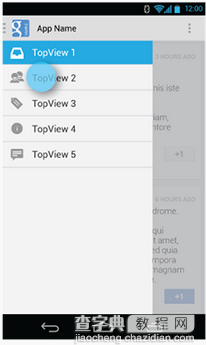
不用切换到另一个页面,也不用去按菜单的硬件按钮,直接在界面上一个按钮点击,菜单就滑出来,而且感觉能放很多东西。
库的引用:
首先, DrawerLayout这个类是在Support Library里的,需要加上android-support-v4.jar这个包。
然后程序中用时在前面导入import android.support.v4.widget.DrawerLayout;
如果找不到这个类,首先用SDK Manager更新一下Android Support Library,然后在Android SDKextrasandroidsupportv4路径下找到android-support-v4.jar,复制到项目的libs路径,将其Add to Build Path.
代码1
布局:
<RelativeLayout xmlns:android="http://schemas.android.com/apk/res/android" xmlns:tools="http://schemas.android.com/tools" android:layout_width="match_parent" android:layout_height="match_parent" > <android.support.v4.widget.DrawerLayout xmlns:android="http://schemas.android.com/apk/res/android" android:id="@+id/drawer_layout" android:layout_width="match_parent" android:layout_height="match_parent" > <> <> <FrameLayout android:id="@+id/content_frame" android:layout_width="match_parent" android:layout_height="match_parent" /> <> <ListView android:id="@+id/left_drawer" android:layout_width="240dp" android:layout_height="match_parent" android:layout_gravity="left" android:background="#111" android:choiceMode="singleChoice" android:divider="@android:color/transparent" android:dividerHeight="0dp" /> </android.support.v4.widget.DrawerLayout> </RelativeLayout>
DrawerLayout的第一个子元素是主要内容,即抽屉没有打开时显示的布局。这里采用了一个FrameLayout,里面什么也没放。
DrawerLayout的第二个子元素是抽屉中的内容,即抽屉布局,这里采用了一个ListView。
主要的Activity(从官方实例中扒出来的):
package com.example.hellodrawer; import android.os.Bundle; import android.app.Activity; import android.content.res.Configuration; import android.view.MenuItem; import android.view.View; import android.widget.AdapterView; import android.widget.AdapterView.OnItemClickListener; import android.widget.ArrayAdapter; import android.widget.ListView; import android.support.v4.app.ActionBarDrawerToggle; import android.support.v4.view.GravityCompat; import android.support.v4.widget.DrawerLayout; public class HelloDrawerActivity extends Activity { private String[] mPlanetTitles; private DrawerLayout mDrawerLayout; private ActionBarDrawerToggle mDrawerToggle; private ListView mDrawerList; @Override public void onCreate(Bundle savedInstanceState) { super.onCreate(savedInstanceState); setContentView(R.layout.activity_hello_drawer); mDrawerLayout = (DrawerLayout) findViewById(R.id.drawer_layout); // init the ListView and Adapter, nothing new initListView(); // set a custom shadow that overlays the main content when the drawer // opens mDrawerLayout.setDrawerShadow(R.drawable.drawer_shadow, GravityCompat.START); mDrawerToggle = new ActionBarDrawerToggle(this, mDrawerLayout, R.drawable.ic_drawer, R.string.drawer_open, R.string.drawer_close) { /** Called when a drawer has settled in a completely closed state. */ public void onDrawerClosed(View view) { invalidateOptionsMenu(); // creates call to // onPrepareOptionsMenu() } /** Called when a drawer has settled in a completely open state. */ public void onDrawerOpened(View drawerView) { invalidateOptionsMenu(); // creates call to // onPrepareOptionsMenu() } }; // Set the drawer toggle as the DrawerListener mDrawerLayout.setDrawerListener(mDrawerToggle); // enable ActionBar app icon to behave as action to toggle nav drawer getActionBar().setDisplayHomeAsUpEnabled(true); // getActionBar().setHomeButtonEnabled(true); // Note: getActionBar() Added in API level 11 } private void initListView() { mDrawerList = (ListView) findViewById(R.id.left_drawer); mPlanetTitles = getResources().getStringArray(R.array.planets_array); // Set the adapter for the list view mDrawerList.setAdapter(new ArrayAdapter<String>(this, R.layout.list_item, mPlanetTitles)); // Set the list's click listener mDrawerList.setOnItemClickListener(new OnItemClickListener() { @Override public void onItemClick(AdapterView<?> parent, View view, int position, long id) { // Highlight the selected item, update the title, and close the // drawer mDrawerList.setItemChecked(position, true); setTitle(mPlanetTitles[position]); mDrawerLayout.closeDrawer(mDrawerList); } }); } @Override protected void onPostCreate(Bundle savedInstanceState) { super.onPostCreate(savedInstanceState); // Sync the toggle state after onRestoreInstanceState has occurred. mDrawerToggle.syncState(); } @Override public void onConfigurationChanged(Configuration newConfig) { super.onConfigurationChanged(newConfig); mDrawerToggle.onConfigurationChanged(newConfig); } @Override public boolean onOptionsItemSelected(MenuItem item) { // Pass the event to ActionBarDrawerToggle, if it returns // true, then it has handled the app icon touch event if (mDrawerToggle.onOptionsItemSelected(item)) { return true; } // Handle your other action bar items... return super.onOptionsItemSelected(item); } }
比较纠结的是用了Level 11的一个API,这样minSdkVersion就有限制,不能太低。
图片资源Android官网示例处提供下载了。
程序运行后效果如下:
抽屉打开前:
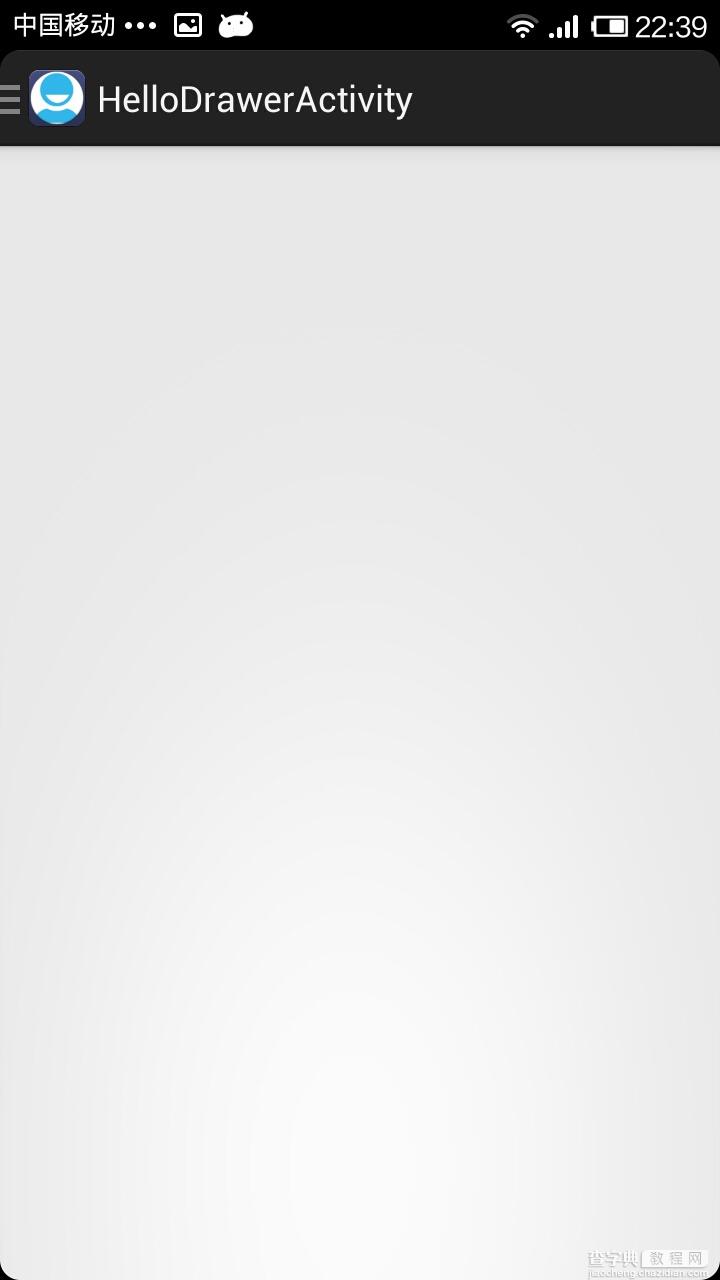
抽屉打开后:
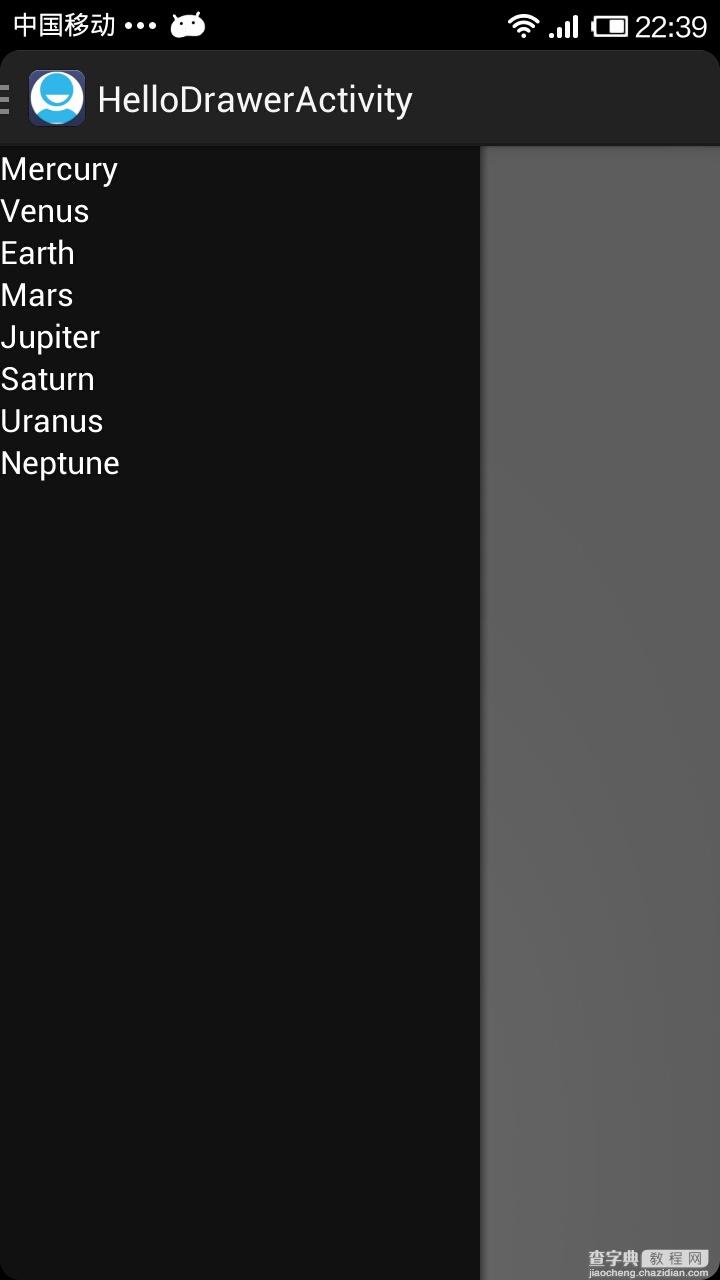
代码2
今天又看了一下DrawerLayout的类,发现有很多方法可以直接用的。
重新试了一下,其实不用上面那么麻烦,随便自己定义一个按钮控制抽屉的打开就行:
布局:
<RelativeLayout xmlns:android="http://schemas.android.com/apk/res/android" xmlns:tools="http://schemas.android.com/tools" android:layout_width="match_parent" android:layout_height="match_parent" android:paddingBottom="@dimen/activity_vertical_margin" android:paddingLeft="@dimen/activity_horizontal_margin" android:paddingRight="@dimen/activity_horizontal_margin" android:paddingTop="@dimen/activity_vertical_margin" tools:context=".DrawerActivity" > <android.support.v4.widget.DrawerLayout android:id="@+id/drawer_layout" android:layout_width="match_parent" android:layout_height="match_parent" > <> <FrameLayout android:id="@+id/content_frame" android:layout_width="match_parent" android:layout_height="match_parent" > <Button android:id="@+id/btn" android:layout_width="match_parent" android:layout_height="wrap_content" android:text="open" /> </FrameLayout> <> <ListView android:id="@+id/left_drawer" android:layout_width="240dp" android:layout_height="match_parent" android:layout_gravity="start" android:background="#111" android:choiceMode="singleChoice" android:divider="@android:color/transparent" android:dividerHeight="0dp" /> </android.support.v4.widget.DrawerLayout> </RelativeLayout>
主要代码:
package com.example.hellodrawer; import android.os.Bundle; import android.app.Activity; import android.support.v4.widget.DrawerLayout; import android.view.Gravity; import android.view.View; import android.view.View.OnClickListener; import android.widget.Button; public class DrawerActivity extends Activity { private DrawerLayout mDrawerLayout = null; @Override protected void onCreate(Bundle savedInstanceState) { super.onCreate(savedInstanceState); setContentView(R.layout.activity_drawer); mDrawerLayout = (DrawerLayout) findViewById(R.id.drawer_layout); Button button = (Button) findViewById(R.id.btn); button.setOnClickListener(new OnClickListener() { @Override public void onClick(View v) { // 按钮按下,将抽屉打开 mDrawerLayout.openDrawer(Gravity.LEFT); } }); } }
使用Toolbar + DrawerLayout快速实现高大上菜单侧滑
如果你有在关注一些遵循最新的Material Design设计规范的应用的话(如果没有,假设你有!),也许会发现有很多使用了看起来很舒服、很高大上的侧滑菜单动画效果,示例如下(via 参考2):
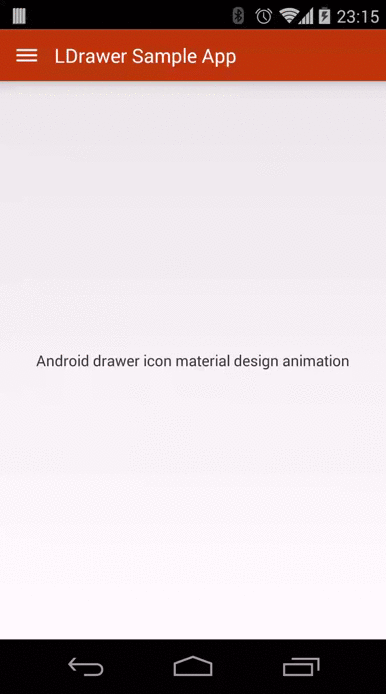
今天就来使用官方支持库来快速实现这类效果,需要使用到Toolbar和DrawerLayout,详细步骤如下:(如果你还不知道这两个Widget,先自己Google吧~)
首先需要添加appcompat-v7支持:
如果是在Android Studio 1.0 RC4上创建的项目,默认已经添加了appcompat-v7支持了,如果不是最新版AS则需要在build.gradle中添加如下代码:
dependencies { ...//其他代码 compile 'com.android.support:appcompat-v7:21.0.2' }
添加完成后需要同步一下gradle
添加Toolbar:
由于Toolbar是继承自View,所以可以像其他标准控件一样直接主布局文件添加Toolbar,但是为了提高Toolbar的重用效率,可以在layout创建一个custom_toolbar.xml代码如下:
<"1.0" encoding="utf-8"?> <android.support.v7.widget.Toolbar xmlns:android="http://schemas.android.com/apk/res/android" xmlns:app="http://schemas.android.com/apk/res-auto" android:id="@+id/tl_custom" android:layout_width="match_parent" android:layout_height="wrap_content" android:background="?attr/colorPrimary" android:minHeight="?attr/actionBarSize" android:popupTheme="@style/ThemeOverlay.AppCompat.Light" app:theme="@style/ThemeOverlay.AppCompat.ActionBar"> </android.support.v7.widget.Toolbar>
说明:
android.support.v7.widget.Toolbar - 当然如果只在Lollipop中可以直接使用Toolbar而不需要加上v7支持
xmlns:app - 自定义xml命名控件,在AS中可以直接指定res-auto而不需要使用完整包名
android:background 和 android:minHeight 均可以在styles.xml中声明
添加DrawerLayout:
和Toolbar类似,为了提高代码重用效率,可以在layout中创建一个custom_drawerlayout.xml代码如下:
<"1.0" encoding="utf-8"?> <android.support.v4.widget.DrawerLayout xmlns:android="http://schemas.android.com/apk/res/android" android:id="@+id/dl_left" android:layout_width="match_parent" android:layout_height="match_parent"> <> <LinearLayout android:layout_width="match_parent" android:layout_height="match_parent"> <ImageView android:id="@+id/iv_main" android:layout_width="100dp" android:layout_height="100dp" /> </LinearLayout> <> <LinearLayout android:layout_width="match_parent" android:layout_height="match_parent" android:background="#fff" android:layout_gravity="start"> <ListView android:id="@+id/lv_left_menu" android:layout_width="match_parent" android:layout_height="match_parent" android:divider="@null" android:text="DrawerLayout" /> </LinearLayout> </android.support.v4.widget.DrawerLayout>
Drawerlayout标签中有两个子节点,一个是左边菜单,一个是主布局,另外需要在左边菜单起始位置设置为android:layout_gravity="start"
实现activity_main.xml:
<LinearLayout xmlns:android="http://schemas.android.com/apk/res/android" xmlns:tools="http://schemas.android.com/tools" android:layout_width="match_parent" android:layout_height="match_parent" android:orientation="vertical" tools:context=".MainActivity"> <> <include layout="@layout/custom_toolbar" /> <> <include layout="@layout/custom_drawerlayout" /> </LinearLayout>
直接使用include标签,简洁明了
完善Java代码:
public class MainActivity extends ActionBarActivity { //声明相关变量 private Toolbar toolbar; private DrawerLayout mDrawerLayout; private ActionBarDrawerToggle mDrawerToggle; private ListView lvLeftMenu; private String[] lvs = {"List Item 01", "List Item 02", "List Item 03", "List Item 04"}; private ArrayAdapter arrayAdapter; private ImageView ivRunningMan; private AnimationDrawable mAnimationDrawable; @Override protected void onCreate(Bundle savedInstanceState) { super.onCreate(savedInstanceState); setContentView(R.layout.activity_main); findViews(); //获取控件 //京东RunningMan动画效果,和本次Toolbar无关 mAnimationDrawable = (AnimationDrawable) ivRunningMan.getBackground(); mAnimationDrawable.start(); toolbar.setTitle("Toolbar");//设置Toolbar标题 toolbar.setTitleTextColor(Color.parseColor("#ffffff")); //设置标题颜色 setSupportActionBar(toolbar); getSupportActionBar().setHomeButtonEnabled(true); //设置返回键可用 getSupportActionBar().setDisplayHomeAsUpEnabled(true); //创建返回键,并实现打开关/闭监听 mDrawerToggle = new ActionBarDrawerToggle(this, mDrawerLayout, toolbar, R.string.open, R.string.close) { @Override public void onDrawerOpened(View drawerView) { super.onDrawerOpened(drawerView); mAnimationDrawable.stop(); } @Override public void onDrawerClosed(View drawerView) { super.onDrawerClosed(drawerView); mAnimationDrawable.start(); } }; mDrawerToggle.syncState(); mDrawerLayout.setDrawerListener(mDrawerToggle); //设置菜单列表 arrayAdapter = new ArrayAdapter(this, android.R.layout.simple_list_item_1, lvs); lvLeftMenu.setAdapter(arrayAdapter); } private void findViews() { ivRunningMan = (ImageView) findViewById(R.id.iv_main); toolbar = (Toolbar) findViewById(R.id.tl_custom); mDrawerLayout = (DrawerLayout) findViewById(R.id.dl_left); lvLeftMenu = (ListView) findViewById(R.id.lv_left_menu); } }
当然比较重要还有styles.xml和colors.xml,具体如下:
<resources> <style name="AppTheme" parent="Theme.AppCompat.Light.NoActionBar"> <> <item name="colorPrimaryDark">@color/Indigo_colorPrimaryDark</item> <> <item name="colorPrimary">@color/Indigo_colorPrimary</item> <> <item name="drawerArrowStyle">@style/AppTheme.DrawerArrowToggle</item> </style> <style name="AppTheme.DrawerArrowToggle" parent="Base.Widget.AppCompat.DrawerArrowToggle"> <item name="color">@android:color/white</item> </style> </resources> <"1.0" encoding="utf-8"?> <resources> <color name="Indigo_colorPrimaryDark">#303f9f</color> <color name="Indigo_colorPrimary">#3f51b5</color> <color name="Indigo_nav_color">#4675FF</color> </resources>
到此就实现了高大上菜单侧滑,最终效果如下(注:在Yosemite上貌似直接Record手机屏幕貌似不起作用,而且动画由于帧率原因无法实时,就先这样看吧~)
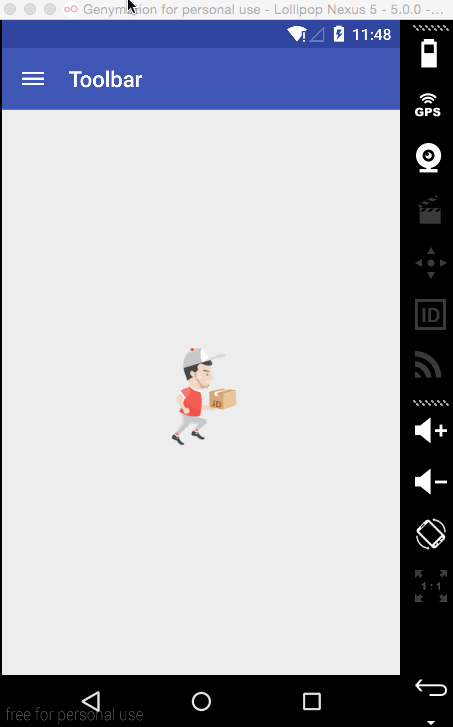
【Android App中DrawerLayout抽屉效果的菜单编写实例】相关文章:
★ php中get_defined_constants函数用法实例分析
